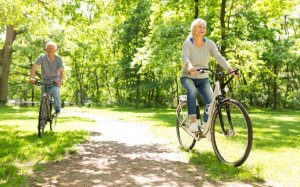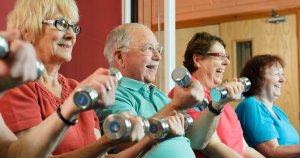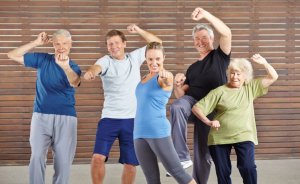What is Active Aging?

Active aging is a concept defined by the World Health Organization (WHO). It’s defined as the process of optimizing health, participation and safety opportunities. In order to improve the quality of life as people get older.
Active aging applies to both individuals and population groups. It allows people to realize their potential; physical, social and mental well-being throughout their life cycle. Also, it allows for participating in society according to their needs, desires, and abilities. All this, while providing them with protection, security, and proper care when they need assistance.
The four pillars of active aging
- Health (physical and mental). Good health helps you feel better and be more active.
- Participation in society. Both institutions and different governments must work to maintain the autonomy, well-being, and health of our elders.
- Security. Having confidence in yourself will make you achieve your goals.
- Lifelong learning. Don’t stop learning for many years to come, there are always new things to learn.

Things to keep in mind for active aging
– Healthy life habits. After 50 years of age, we should start to create and follow certain healthy habits and maintain them for the rest of our life. If for example, we create the habit of going for a walk for one hour every day, it’s unlikely that after many years we’ll stop practicing this activity.
-Exercise. It’s advisable to exercise every day, either walking or doing an activity according to our state of health and age. The important thing is to remain active.
-Have a healthy diet. It’s advisable, depending on the time of year and personal needs, that the diet is healthy and balanced so that it provides us with the nutrients we need. Never stop eating fruit and vegetables and avoid foods rich in fats and sugars. To add to this, drink water often, about two liters a day.

-Get in touch with nature. Especially when the weather is good, nature brings important benefits to our body. A trip to the countryside or a simple walk along a river will allow us to enjoy contact with our environment. If you have pets, this is also positive, as they give unconditional love.
-How to take care of health. Each person needs to maintain different health habits and it’s very important to have adequate control of them. Regular visits to the doctor, taking necessary medications, and avoiding tobacco or alcohol use, are all essential habits for active aging.
-Maintain good social and family relationships. People help people, and personal relationships are very important at all stages of our lives. Both of these are maintained with friends, neighbors or people close to us, as well as those established within a family itself. Relationships are determinants for personal well-being.

-Develop a skill. In addition to leisure, exercise, and good conversation, we must stay busy to the extent that our health allows it. Participate in activities, join a workshop, develop a skill at home. Any occupation is beneficial and leads to active aging.
In summary, it’s important that as people advance in age, they follow healthy habits. If we follow the advice described above, we’ll achieve aging with a certain quality of life, something that isn’t always easy.
Active aging is a concept defined by the World Health Organization (WHO). It’s defined as the process of optimizing health, participation and safety opportunities. In order to improve the quality of life as people get older.
Active aging applies to both individuals and population groups. It allows people to realize their potential; physical, social and mental well-being throughout their life cycle. Also, it allows for participating in society according to their needs, desires, and abilities. All this, while providing them with protection, security, and proper care when they need assistance.
The four pillars of active aging
- Health (physical and mental). Good health helps you feel better and be more active.
- Participation in society. Both institutions and different governments must work to maintain the autonomy, well-being, and health of our elders.
- Security. Having confidence in yourself will make you achieve your goals.
- Lifelong learning. Don’t stop learning for many years to come, there are always new things to learn.

Things to keep in mind for active aging
– Healthy life habits. After 50 years of age, we should start to create and follow certain healthy habits and maintain them for the rest of our life. If for example, we create the habit of going for a walk for one hour every day, it’s unlikely that after many years we’ll stop practicing this activity.
-Exercise. It’s advisable to exercise every day, either walking or doing an activity according to our state of health and age. The important thing is to remain active.
-Have a healthy diet. It’s advisable, depending on the time of year and personal needs, that the diet is healthy and balanced so that it provides us with the nutrients we need. Never stop eating fruit and vegetables and avoid foods rich in fats and sugars. To add to this, drink water often, about two liters a day.

-Get in touch with nature. Especially when the weather is good, nature brings important benefits to our body. A trip to the countryside or a simple walk along a river will allow us to enjoy contact with our environment. If you have pets, this is also positive, as they give unconditional love.
-How to take care of health. Each person needs to maintain different health habits and it’s very important to have adequate control of them. Regular visits to the doctor, taking necessary medications, and avoiding tobacco or alcohol use, are all essential habits for active aging.
-Maintain good social and family relationships. People help people, and personal relationships are very important at all stages of our lives. Both of these are maintained with friends, neighbors or people close to us, as well as those established within a family itself. Relationships are determinants for personal well-being.

-Develop a skill. In addition to leisure, exercise, and good conversation, we must stay busy to the extent that our health allows it. Participate in activities, join a workshop, develop a skill at home. Any occupation is beneficial and leads to active aging.
In summary, it’s important that as people advance in age, they follow healthy habits. If we follow the advice described above, we’ll achieve aging with a certain quality of life, something that isn’t always easy.
This text is provided for informational purposes only and does not replace consultation with a professional. If in doubt, consult your specialist.








